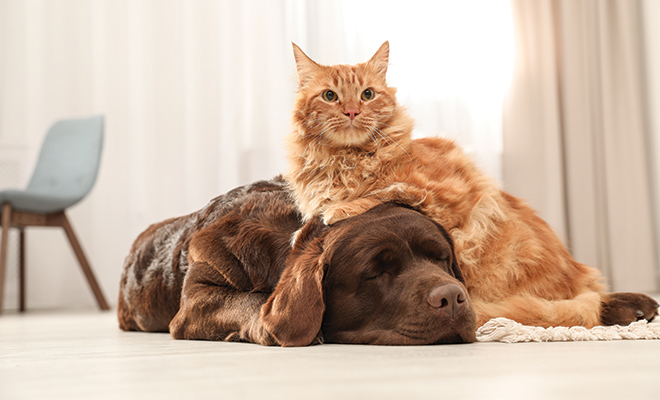
One + One + Pets: Making Marriage a Successful Transition for Pets
You and a significant other are making one home. A roommate has been added to your apartment. Your elderly parents have asked you to move in to assist with their healthcare. In each case, not only are you blending people, but you may also be blending pets. Whenever you’re bringing together fur babies from different homes, you can experience a tail-wagging happy household or a combative, fur-flying disaster.
“It’s critical to ensure the pets’ introductions are a positive experience. You don’t want to ignore one or the other so ensure your pets get plenty of attention and positive reinforcement,” shared Ann Brown, DVM. “Make it as enjoyable as possible and know this will take everyone’s involvement. Talk as a couple on a game plan, and remember, people must stay calm because our animals can feel our stress.”
This game plan must include the species you’re introducing to one another, their ages, gender, the number of animals and their individual personalities. Although there’s not a set time frame for this process to be completed, Dr. Brown urges pet owners to take it gently and gradually. “Go slowly and allow both pets and families to get to know one another. Much of the process depends on the pets; some dogs may be best friends right away. On the other hand, for a cat and dog, if they haven’t been around one another, it will take a while to make that transition comfortably and safely,” remarked Dr. Brown. “The last thing you want to happen is for one of the pets to get hurt, scared, traumatized or experience behavioral problems, such as aggression or chewing on things. You have enough stress with moving in with one another; you don’t need the stress of pets not getting along.”
In many cases, households are blending a cat with a dog, two different species. The stress on the animals and humans along with the potential danger can be a huge risk, but a happy household can be realized. “We want to keep the dog confined and let the cat have free reign. I’d advise having the dog on a leash or in a crate while allowing the cat to explore and smell. It’s far easier to confine and restrain a dog and let the cat be free,” shared Dr. Brown. “Ideally, both humans should be involved, whoever is most comfortable in each position. One would be with the dog to help it stay calm and offer treats, and the other person would be with the cat, also giving treats. You don’t want a nose-to-nose interaction in which the cat could be bitten or it could take a swipe.”
When blending households containing two or more cats, the process should be even more deliberate and thoughtful. “Cats can be independent creatures, and I would give each one an opportunity to explore the surroundings without the other cat present. Move them throughout the house to discover and smell where the other cat has been,” commented Dr. Brown. “Observing how they react to the odor of another cat is in the house will help you know how they will respond when they finally meet. If there’s hissing through the door, then a longer introduction is certainly recommended. A technique you can use before you even introduce the cat into their new environment is to brush one cat and use the same brush on the other cat. You’re transferring that odor, and they can smell the other cat via the brush. And don’t forget to reinforce the cat knows where the litter box is located. Consider offering multiple litter boxes in different places so the potential for accidents is diminished.”
While the best advice and thoroughly considered game plan do not automatically spell success, it is a solid foundation for ensuring there is a light at the end of the tunnel. “In most situations, it may take time, but typically everyone will find their new groove. It just takes time for pets and humans. The biggest concerns are for aggression and the safety of each pet. If things aren’t going well, bring in a well-respected trainer or animal behavior specialist. Check with your veterinarian for good resources,” stated Dr. Brown. “Depending on the animal, if you already have a nervous pet that doesn’t handle change well, talk with your veterinarian before the introductions. You might be able to put them on anti-anxiety meds during this process. Over-the-counter pheromones have shown to decrease anxiety for cats and dogs.”
If you’ll soon be blending households and your pets, you owe it to yourself and your fur babies to have a solid game plan in place. Do your research, and if you have concerns, reach out to your veterinarian for advice. Get moving in the right direction and on the right paw for the purr-fect solution. ■







